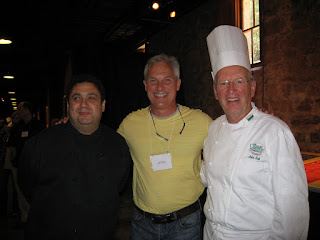Wednesday, July 29, 2009
International Pinot Noir Celebration
Thursday, July 16, 2009
"40 Things Every Wine Lover Should Do," Decanter
In the recently arrived August issue of Decanter (my favorite wine magazine), Margaret Rand wrote a fun article, "40 Things Every Wine Lover Should Do." Here they are.
1. "Learn to decant" This is an easy one.
2. "Buy some mouth-blown Riedel glasses (and then drop on)...Now, you've got four instead of six and you begin to wonder if maybe you could make do with something cheaper. There's a great feeling of liberation when you've smashed some of your most treasured stemware."
3. "Marry a winegrower...You have to like living in the country."
4. "Drink wine from your birth year"
5. "Make love in a vineyard" (Do I have your attention?) "German vineyards might be perilously steep; parts of Chateauneuf du Pape would be uncomfortably stony." She bet on the "sheltered corners" of Burgundy. I can't speak from experience, unfortunately, but I can see the possibilities. Of course, this would likely arouse the ghosts of those long ago Cistercian monks.
6. "Dine off of fois gras and Chateau d'Yquem"
7. "Drink first growth from a plastic cup with a takeway" (movie "Sideways")
8. "Visit Vega Sicilia" Most famous wine estate in Spain....Fort Knox is easier to get into.
9. "Drink Madeira from when Marie Antoinette was on the throne of France (or at least when Victoria was on the British)" Or when Calvin Coolidge was President.
10. "Pick up fossils in a Chablis grand cru vineyard"
11. "Go to a charity wine auction"
12. "Watch the races on the beach in Sanlucar de Barrameda" Back to the horse again.
13. "Drink Gruner Veltliner by the half-litre at a Buschenschank"
14. "Start a wine club"
15. "Stay at Les Crayeres in Champagne"
16. "Eat grapes from a great vineyard" Be careful
17. "Do an architecture-and-wine tour of Rioja"
18. "Try Essencia from Tokaj"
19." Take the train from Oporto to Pinhao"
20. "Take a wine tour by camel in McLaren Vale" I know at least one take on this one.
21. "Tread Port grapes in a Lager" Lucille Ball beat us to it.
22. "Sabre a bottle of Champagne" A how to video is in the movie "Bottle Shock."
23. "Do a wine course...."
24. "Buy wine direct from a wine estate's cellar door"
25. "Drink vintage Port young, with pudding"
26. "Take a helicopter tour of a wine area"
27. "Try Ice Wine..." That's not ice in a glass of wine.
28. "Run the Medoc marathon..." "lots of wine and oyster shops en route." Are there any finishers?
29. "Recognize a corked wine and argue (successfully) with the sommelier" Been there, done that.
30. "Breakfast on top vintage Champagne." Now were talking
31. "Plan a dinner party solely around the wines"
32. "Visit the cellars at Chateau de Beaune"
33. "Work a vintage" Be careful what you ask for. Oh! My breaking back.
34. "Have lunch at the Factory House" (in Oporto)
35. "Drink wines made from vines older than you."
36. "Buy a case in primeur" (futures)
37. "Discover the Loire Valley castles and vineyards by bike" High on my list.
38. "Get lost in Pomerol" Getting lost anywhere is never a problem for me.
39. "Go kangaroo-spotting in the Hunter Valley" Cool!
40. "And...drink your best bottles" This sounds obvious, but better to drink too young than too old.
Early Harvest Report from Burgundy
Thursday, July 9, 2009
Value in Revana


Recently I visited my San Francisco friends and serious food and wine lovers, Ilene and Jeff Bragman. I was in California for the Beyond Extra Virgin olive oil conference and had one day following the conference to explore Napa Valley. I had not been to Napa since attending the wine studies program at the Culinary Institute of America at Greystone in the spring of 2005. Being a bit out of touch since most of my recent wine travels have been in France, I asked Jeff to recommend a few high quality, under the radar Napa wineries to visit. Jeff, who has an extraordinary wine cellar and is an astute and well-informed California wine enthusiast, gave me a short list. At the top and written in bold letters was REVANA.
Now, let’s get to the juice. Revana Family Vineyards is a portfolio of one. There is no Sauvignon Blanc, Chardonnay, Zinfandel, or lesser bottling of Cabernet Sauvignon. Revana is totally committed to a single Bordeaux blend of Cabernet Sauvignon, Cabernet Franc and Petit Verdot. The focus is on producing one exceptional wine by masterfully blending the seven blocks spread over nine acres. This is the Bordelais way, but even they have a second label. As another example, I have always respected the traditional single label Chateauneuf du Papes producers such as Clos des Papes, Domaine Charvin and Vieux Donjon. They have not surrendered to the lucrative lure of multiple single vineyard bottlings and higher prices for each. They contend that the blending adds to the complexity and consistency each year.
By the way, the other wineries on Jeff's list were Frank Family, Hall and Alpha-Omega. Stay tuned for more on these.
Tuesday, July 7, 2009
Beyond Extra Virgin Conference Recap






